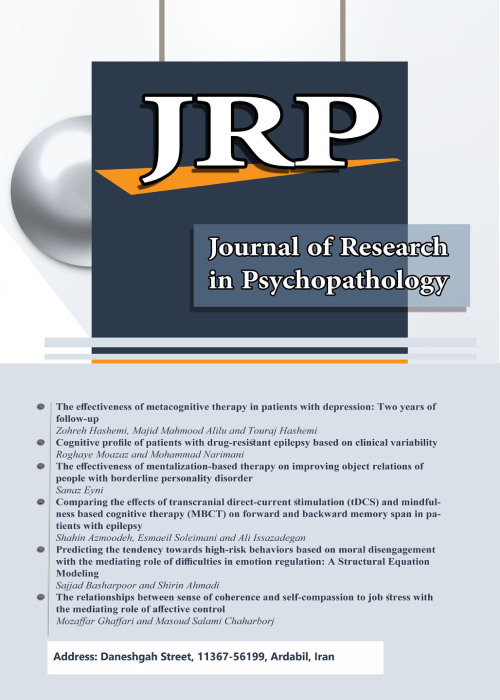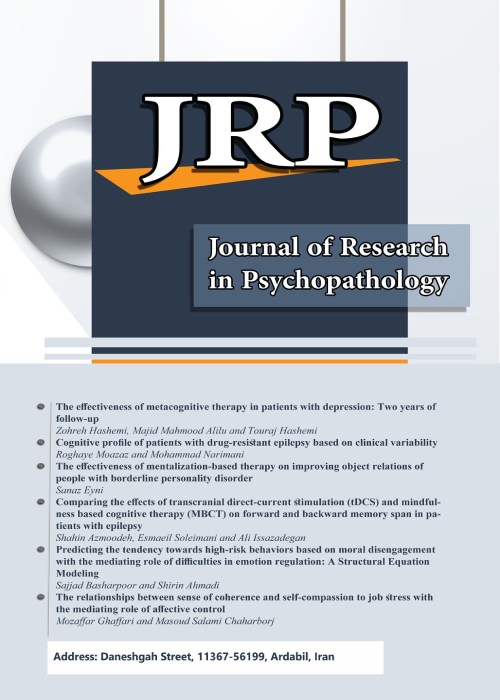فهرست مطالب

Journal of Research in Psychopathology
Volume:3 Issue: 10, Autumn 2022
- تاریخ انتشار: 1401/10/10
- تعداد عناوین: 6
-
-
Pages 1-11This study aimed to compare impulsivity, emotional instability, decision-making, and high-risk behaviors in individuals with bipolar disorder (BD) and borderline personality disorder (BPD). The present study was a comparative causal study. The statistical population of the present study includes patients with BD and BPD in psychiatric centers and psychiatric hospitals in Tabriz in 2020. The sample consisted of 2 groups of 50 people, each of which was selected based on a semi-structured clinical interview. Research instruments included the Bart impulsivity questionnaire, Eisenhower personality questionnaire, Iowa gambling test, and Mohammadi high-risk behaviors questionnaire. Multivariate analysis of variance (MANOVA) was used to analyze the hypotheses. The results showed that compared to BPD, participants with BD have significantly higher mean scores in impulsivities and high-risk decision-making (p < .05). On the contrary, the results also indicated that the mean scores of emotional instability and high-risk behaviors were higher in BPD (p < .05). Findings of the present study point to the fact that individuals with BD and BPD have unique problems in terms of impulsivity, high-risk decision-making, emotional instability, and high-risk behaviors. Thus, these findings must be taken into account by the healthcare specialists in order to provide effective and individualized treatments.Keywords: impulsivity, Emotional instability, Decision making, high-risk behaviors, Bipolar disorder, Borderline personality disorder
-
Pages 12-17Negative personality traits in mothers play an important role in children's behavioral problems. The aim of this study was to compare the severity of Attention Deficit/Hyperactivity Disorder (ADHD) and Oppositional Defiant Disorder (ODD) symptoms in female children of mothers with high and low negative perfectionism. The research method was causal-comparative. The population of this study consisted of mothers of girls aged 5 to 7 years in Arak (N=5522). Using cluster sampling, 448 mothers participated in this study. The Positive and Negative Perfectionism Scales and the Child Symptoms Scale were used to collect data. Multivariate analysis of variance (MANOVA) was used to analyze the data. The results showed that the severity of ADHD and ODD symptoms were higher in female children of mothers with high negative perfectionism than those with low negative perfectionism (p < 0.05). Based on the findings, paying attention to the negative aspects of mothers' negative perfectionism and educational workshops are suggested.Keywords: ADHD, Children, mothers, Negative perfectionism, ODD
-
Pages 18-26The present study investigated the relationship between early maladaptive schemas and suicidal ideation in girls with the mediating role of emotion regulation strategies. The research method was descriptive-correlational, and the structural equation method was used to test the relationships between variables. The population of this research was all female students studying at Alzahra university of Tehran in 2022. To conduct this research, 323 girls participated in this study using convenience sampling. The subjects responded to Yang's Maladaptive Schema Questionnaire (short form), Beck's Suicidal Ideation Questionnaire (1979), and Garnefski and Kraaij 's Cognitive Emotional Regulation Questionnaire (2001). Answers were received through online platforms and an electronic questionnaire. The data were analyzed in two ways: descriptive statistics using SPSS 26 and inferential statistics using structural equation modeling in SMART PLS 3. The results showed that early maladaptive schemas correlate with suicidal thoughts, adaptive emotion regulation strategies, and maladaptive emotion regulation strategies (p=0.001). In addition, the adaptive emotion regulation strategies have no significant relationship with reducing suicidal thoughts (p=0.162). However, maladaptive emotion regulation strategies can increase suicidal thoughts. Suicidal thoughts were not mediated by adaptive emotion regulation strategies, unlike maladaptive emotions regulation strategies. (p=0.142). Therefore, the results of this research showed that the use of adaptive emotion regulation strategies is not effective in reducing suicidal thoughts. Consequently, it can be concluded that educating individuals on how to regulate their emotions while facing maladaptive strategies is more effective than addressing adaptive strategies.Keywords: early maladaptive schemas, suicide ideation, emotion regulation strategies
-
Pages 27-34This study was performed to evaluate the effectiveness of family didactic-therapeutic package on symptoms management in patients with schizophrenia spectrum disorders (SSDs). This experiential study with a clinical trial, had a pretest-posttest design and was conducted in a quasi-experimental manner. The population included all families/caregivers of patients with SSDs who had a case in Ardabil Welfare Office in 2020, and were diagnosed by a psychiatrist (a patient's family refers to his/her father, mother, spouse, or child volunteered to attend the didactic-therapeutic sessions). The sample consisted of 40 patients' caregivers, selected by the convenience sampling, and randomly divided into the experimental (n = 20) and control (n = 20) group. Descriptive statistical methods were used to describe the data, while MANCOVA was performed to test the hypotheses. Significant differences were observed between the experimental and control groups in terms of symptoms management (p < 0.001, F = 17.17). Therefore, the suggested family didactic-therapeutic package could be useful for managing symptoms of patients with SSDs (p < 0.01).Keywords: Family-centered, Symptoms management, Schizophrenia
-
Pages 35-47Inhibitory cognitive rehabilitation and Transcranial Direct Current Stimulation can be therapeutic alternatives to stimulant drugs in attention deficit/hyperactivity disorder, and there is evidence of their effectiveness in improving cognitive function and clinical symptoms. The aim of this study was to compare the effectiveness of cognitive rehabilitation of inhibitory control, transcranial direct current stimulation and the combination of inhibitory control rehabilitation and transcranial direct current stimulation on inhibitory control and working memory of children with attention deficit hyperactivity disorder. The method of the present study is quasi-experimental with an unbalanced control group design. The quasi-experimental design of the present study was pre-test-post-test and follow-up (2 months) with the control group. The population included all those with ADHD disorder in Arak in the academic year of 2019-2020. The sample consisted of 60 students in the age range of 8 -12 in Arak who referred to counseling centers and student psychological services and answered the Swanson Attention Deficit Hyperactivity Disorder Questionnaire. The students were assigned to experimental and control groups (15 individuals in each group). To collect the data, Swanson et al.'s Attention Deficit Hyperactivity Disorder Questionnaire, N-Back Kirchner test and Stroop computer test were used. The experimental group received a rescue inhibitory cognitive rehabilitation program, and transcranial direct current stimulation and a combination of these programs over the F4 points. The data were analyzed using SPSS.26 software and mixed covariance analysis with repeated measures. The results showed that inhibitory cognitive rehabilitation, Transcranial Direct Current Stimulation and combination of inhibitory cognitive rehabilitation of Transcranial Direct Current Stimulation are effective on the components of inhibitory control and working memory (p ≥ 0.001). The results of Bonferroni post hoc tests showed that there is a significant difference between inhibitory control and working memory of experimental and control groups (p ≥ 0.01). It can be concluded that inhibitory cognitive rehabilitation, Transcranial Direct Current Stimulation and a combination of the two can be used as a single treatment or along with other psychological therapies for children with ADHD.Keywords: Cognitive Rehabilitation of Inhibitory Control, Hybrid treatment Transcranial Direct Current Stimulation inhibitory control, working memory, Attention deficit, hyperactivity disorder
-
Pages 48-55One of the new treatment methods studied and applied by a majority of researchers of autism is body and movement centering methodology. The purpose of this study was to investigate the effectiveness of Kephart’s motor-perception skills training on executive functioning of children with autism spectrum disorders. The research method was quasi-experimental with pre-test-post-test design applied on two experimental and control groups. The population consisted of all children aged 5-18 years old with autism in Arak city in 2019, 30 of whom were selected through the availability sampling. They were randomly assigned to experimental and control groups. The experimental group participated in Kephart’s motor-perception skills training during twelve 12 (three sessions per week), each session for two hours, and no intervention was performed in the control group. The instrument was the Behavior Rating Inventory of Executive Function (BRIEF). The data were analyzed using covariance analysis by SPSS software. Testing the hypothesis of the research, the effectiveness of Kephart’s motor-perception skills training on executive functioning of children with autism spectrum disorders showed that performing Kephart’s training had a significant effect (p < 0.05) on improving the executive functions of children with autism spectrum dysfunction. Therefore, as the students in the upper grades are incompatible with aspects of emotional regulation, this interaction leads to a much greater impact on their emotional problems.Keywords: Autism Spectrum Disorders, Kephart’s motor-perception skills training, Executive Functioning


